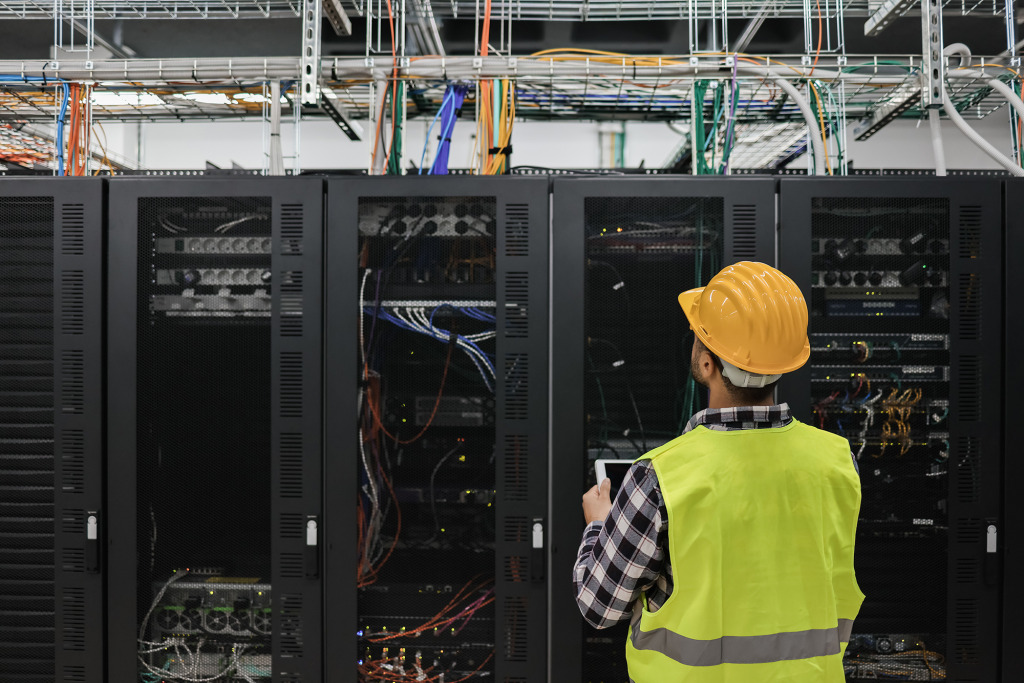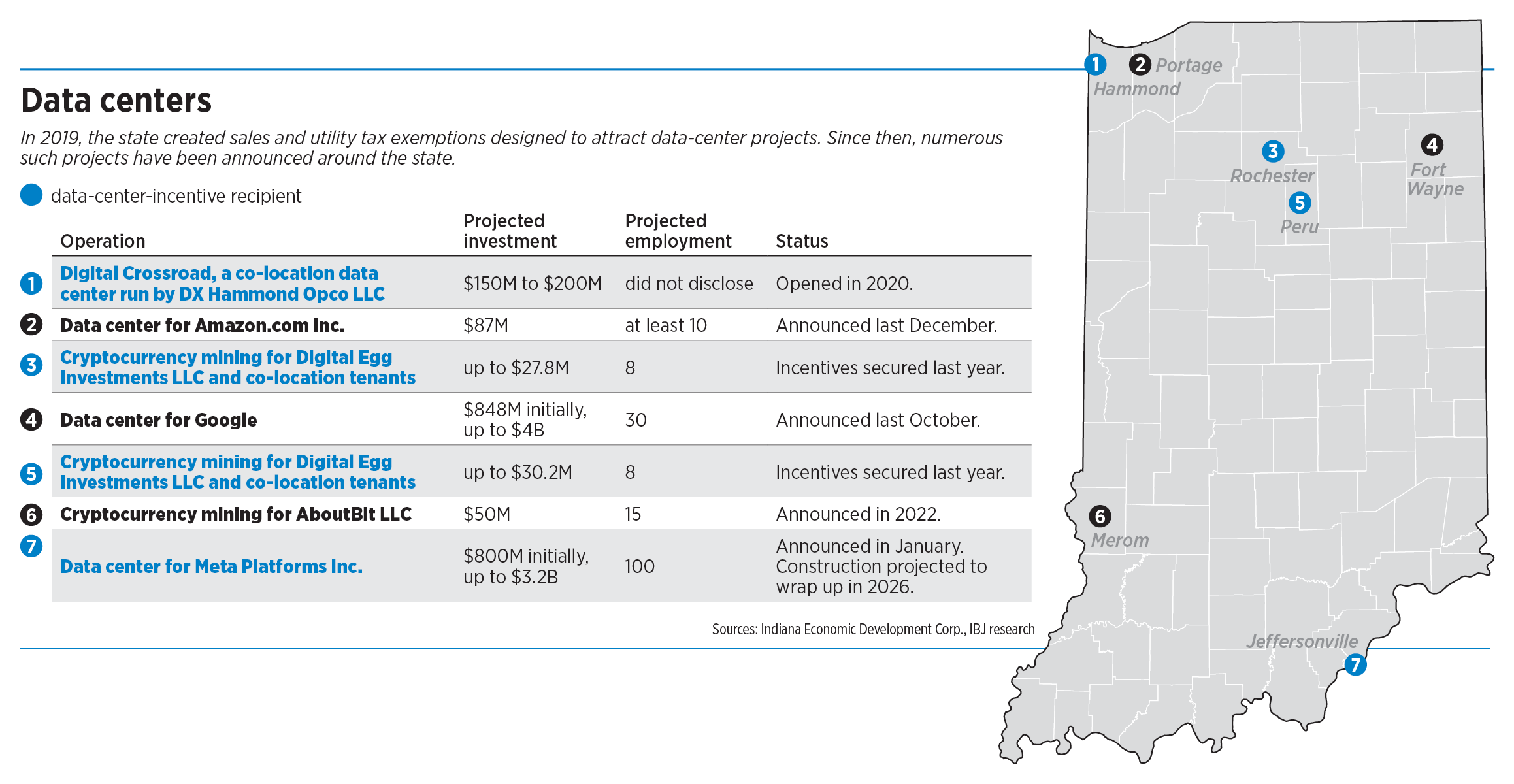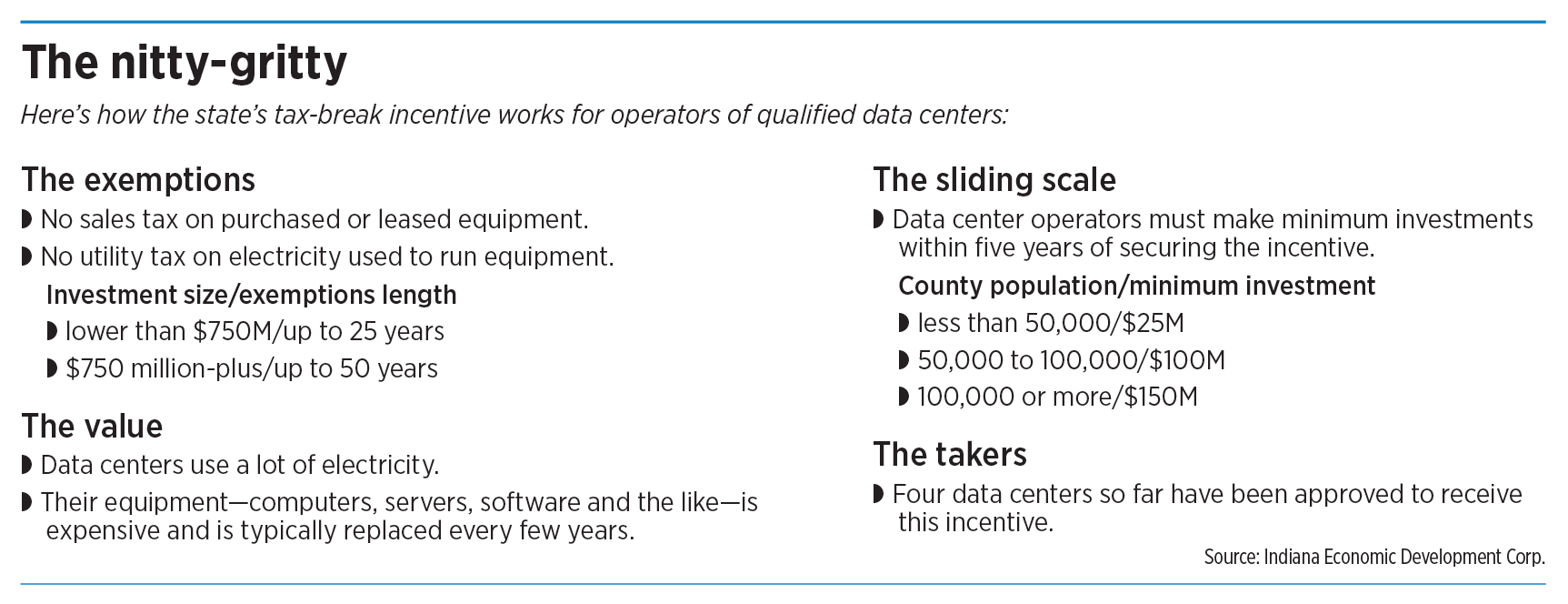Subscriber Benefit
As a subscriber you can listen to articles at work, in the car, or while you work out. Subscribe NowAs digital technology advances, so, too, does the demand for data centers—but until just a few years ago, Indiana was largely sitting on the sidelines while projects went to other states.
That’s begun to change, thanks in part to an economic development incentive the Legislature passed in 2019 aimed specifically at the centers, which house computers, servers, and related hardware and equipment.

Since then, at least seven data center projects have been announced around Indiana, including three since October—for West Coast tech giants Google, Amazon.com Inc. and Meta Platforms Inc. The four other projects include a colocation center—a data center that leases space to tenants—and three cryptocurrency mining operations.
Indiana was not an early adopter of such incentives, nor is it considered a data-center hot spot. The top four markets for data center activity are the Washington, D.C., suburbs of northern Virginia, the Dallas/Fort Worth area, Silicon Valley and Chicago, according to a September report from Dallas-based commercial real estate firm CBRE.
“There were 15 to 20 states that got the jump on us,” said Larry Gigerich, executive managing director at Fishers-based site selection consultancy Ginovus LLC.
But now that the state does have an incentive to lure data centers, “Indiana’s definitely in the game now, and it’s very competitive,” Gigerich said.
Of the seven projects recently announced in Indiana, four have qualified for the state’s data-center incentive, according to the Indiana Economic Development Corp.’s transparency portal.

Mark Wasky, who serves as special counsel to the Indiana secretary of commerce, said the IEDC is not discouraged by the limited number of projects that have been approved for incentives. “The minute that this law passed, we started getting calls that we hadn’t been getting before,” Wasky said.
He noted that data-center projects represent investments that can top $1 billion, and it takes time for such deals to develop.
“We had decades of not seeing any of this investment occur in the state,” he said. “And with that in mind, without incentives, we wouldn’t be seeing this investment occur—at least in a significant way.”
Incentives matter
Companies that qualify for the incentive don’t have to pay sales tax on the purchase of the computers, servers and software in the data center or on the electricity used in running that equipment. The minimum required investment varies depending on where the project is located and ranges from $25 million in counties with less than 50,000 residents up to $150 million in counties with 100,000 or more residents.
Projects that represent up to $750 million in investment can secure the tax break for up to 25 years. Projects investing more than $750 million can lock it in for as long as 50 years.
The amount a data center operator might save over the lifetime of a project is hard to predict. It will vary based on several factors, including the cost of the center’s equipment and how often the equipment is replaced.
According to the fiscal impact statement the Legislative Services Agency prepared for lawmakers when they considered the incentive in 2019, the sales tax exemption on data-center equipment translates to a $1.75 million tax savings on a $25 million investment. A $150 million investment translates to $10.5 million in tax savings.
The fiscal impact statement estimated that Indiana data centers could pay up to $174 million in electricity costs, which is based on the assumption that data centers consumed 1.8% of the state’s $9.7 billion in electricity costs in 2017. Based on those numbers, the tax break would exempt Indiana data centers from paying $12.2 million in sales taxes on those electricity purchases.
Josh Levi, president of the Loudoun County, Virginia-based Data Center Coalition, said incentives are not the only factor site selectors consider. Access to fiber, reliable power, clean energy, affordable land, business and regulatory climate, workforce availability and natural disaster risk are all considered.
But incentives do make a difference, Levi said.
“Data centers involve huge financial investments in buildings and equipment, with some individual projects exceeding $1 billion in capital investment,” Levi told IBJ via email. “Due to the high initial investment and the need for regular replacement of costly equipment, sales and use tax exemptions are a key consideration to the data center industry when choosing U.S. markets in which to enter or expand.”
Levi said Indiana’s incentive is “very competitive” when compared with the more than half of states that have created data-center-focused incentives.
Beyond just jobs
By one traditional economic development metric—job creation—data centers don’t seem like blockbuster projects. They generate relatively few jobs.
In announcing its planned Jeffersonville data center, for instance, Meta said it would invest at least $800 million to establish a 700,000-square-foot facility but create just 100 jobs. And Google’s planned $845 million data center in Fort Wayne is expected to create only about 30 jobs.
But there are other reasons states are hot to land these projects.

One is that the jobs typically have high salaries. Data centers also create jobs for contractors who help build and operate the campus, said Brock Herr, senior vice president of business development at the IEDC.
A data center that employs 50 people, Herr said, typically supports an additional 200 to 300 contractors to help keep the site cool, clean and properly maintained. Those workers include plumbers, electricians, welders, cable installers and the like.
Data centers typically operate around the clock, requiring that they replace their computers and other hardware every three to five years. And they need to make those changes without compromising speed or reliability, Herr said. “You constantly need somebody in there that knows exactly what they’re doing.”
Gigerich said the demand for data centers started to accelerate around 2012 or 2013, and he expects it to continue to grow for another 10 to 15 years. Part of that growth, he said, will come from the rise in artificial intelligence, which requires massive amounts of computing power.

According to a January 2023 report from New York City-based consultant McKinsey & Co., U.S. data-center power consumption is projected to grow about 10% a year until 2030, when consumption will reach 35 gigawatts. That’s up from 17 gigawatts in 2022, and less than 10 gigawatts in 2014.
(A gigawatt, which equals 1 billion watts, is enough to power 100 million LED light bulbs for an hour.)
“It’s a race to get these things to come to the states. It’s truly a race,” said Carmel attorney Tom Dakich, who was involved in the development of Digital Crossroad, a Hammond data center that was the first project to take advantage of Indiana’s incentive.
Dakich was previously the majority owner of Digital Crossroads but has since sold some of his stake and is now a limited partner.
Beyond data centers
Data centers can also serve as a magnet to attract other types of business.
In computing, the term latency refers to the amount of time it takes data to travel from one point to another. Latency is measured in milliseconds, and reducing the distance the data must travel is one way to reduce latency.
“You want to be as close to the data center as you can possibly be,” Dakich said. “Every time you shave a tenth of a millisecond [off of latency times], you get people to write articles about it and pop champagne corks.”
So having a data center can help attract businesses for which fast computing speeds are important.
“Automakers need to process data, life science companies need to process data, large corporate headquarters, even government entities, trading platforms, any of those things are going to require processing data. And they want data to get to their end user as quick as possible,” Herr said.
Aside from his involvement in Digital Crossroads, Dakich is also CEO of the Quantum Corridor, a public-private partnership in northwestern Indiana that is building what it calls one of the fastest and most secure fiber-optic networks in the Western Hemisphere. The network conducted its first transmissions last fall between the Digital Crossroad data center and a data center in Chicago.
“Hammond, Indiana’s on the digital map because of our efforts,” Dakich said.
Indirectly, data centers can also help spur economic development because of their impact on electrical and telecommunications infrastructure, Gigerich said.
“Having these data centers in your state enhances your telecom and electricity availability and capacity, because these often require some level of upgrade that the company actually usually helps pay for,” he said. “And it makes our telecom infrastructure and our electric infrastructure more robust.”
Having more robust infrastructure, Gigerich said, can in turn help a state lure other prospects—such as corporate headquarters, research and development sites and federal research facilities—that need similar infrastructure.•
Please enable JavaScript to view this content.




Data Centers aren’t big employers or high dollar jobs after they go into operation.
A big article about a couple hundred jobs…
The IEDC is missing the mark with trying to attract datacenters.
Tom Dakich is in the news more than his brother Dan these days. And that’s a good thing!
Crypto mining? What a waste.
Yep. THAT needs to be banned.
2 words: BULL SHIT.